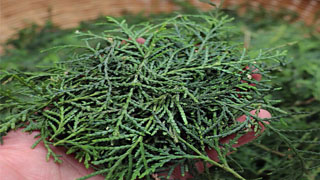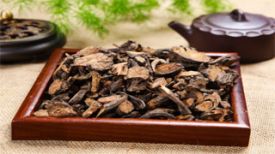
1. Alias
Flat cypress leaves, clump cypress leaves, and cypress leaves.
2. Plant morphology
Evergreen trees. The bark is thin and cracks into long strips; Branches are dense, small branches are flat, scale shaped leaves alternate, monoecious, and the bulbous flowers grow on the top of short branches in the previous year. The cone is oval shaped, initially green, fleshy, covered in white powder, dark brown when ripe, woody, and open; Four pairs of scales, flat, with a pointed tip that curves downwards near the top, and 1-2 seeds in each of the middle scales; Seeds without wings or with ridges. The flowering period is from April to May, and the cones mature in October
3. Origin distribution
Widely distributed, mostly cultivated. Mainly produced in Shandong, Henan, Hebei and other places.
4. Harvesting and processing
Harvested in summer and autumn, dried in the shade.
5. Characteristics of medicinal herbs
The stems and branches of medicinal herbs are often branched, and the small branches are flat. The leaves are small and scaly, alternating and opposite, attached to small branches, dark green to yellow green in color. Crispy and easy to break. It has a fragrant aroma, a bitter and slightly spicy taste.
6. Sexual Taste Returning to the Classics
Cold in nature, bitter and astringent in taste. Return to the lung meridian, liver meridian, and spleen meridian.
7. Effect and Function
Cooling blood to stop bleeding and promote black hair growth. Cold blood hemostatic drugs belonging to the subcategory of hemostatic drugs.
8. Clinical application
Take 6-12 grams and decoct in water. Used to treat vomiting, bleeding, hemoptysis, rectal bleeding, bleeding from collapse, blood heat induced hair loss, and premature graying of hair.
9. Pharmacological research
The bleeding time and anticoagulation time were significantly shortened; The impact on the respiratory system includes cough suppressant, expectorant, and anti asthmatic effects; Resistance to pathogenic microorganisms; calm; It can cause a mild decrease in blood pressure and has a vasodilatory effect on isolated rabbit ear blood vessels. Can still relax the detached intestinal tract. Pharmacological experiments have shown that intraperitoneal injection of 1 g/kg of hot water extract has a hemostatic effect on tail cutting injuries in mice.
10. Chemical composition
Contains chemical components such as volatile oils, flavonoids, wax, fatty acids, and volatile substances. Among them, there are components such as α - thujone, thujone, fennel, pinene, and cypress flavonoids.
11. Usage taboos
Taking it frequently or for a long time can easily cause discomfort in the stomach and wrist, as well as decreased appetite.
12. Compatibility prescription
① To treat pertussis: 15-21g of Platycodon grandiflorus leaves, 9g each of Baibu and Sha Shen, stewed with rock sugar and taken orally. (Fujian Pharmaceutical Journal)
② To treat wind and rheumatism and alleviate pain during festivals, extract juice from the leaves of Platycodon grandiflorus and mix it with fermented rice to make wine and drink. (Baiye Wine from "Gangmu")
③ Treating breast abscess: Using Platycodon grandiflorus leaves and sugar dregs to massage and apply to breast abscess is better than dandelion. (Essentials of Herbal Preparation)
④ To treat mumps: Take an appropriate amount of Platycodon grandiflorus leaves, wash and crush them, add chicken egg white to make a paste and apply it externally. Change the dressing twice a day. (Compilation of Simplified Prescriptions for Traditional Chinese Medicine Herbal Medicine)
⑤ More than just treating vomiting blood: 90 grams each of Platycodon grandiflorus leaves and dried ginger, and three sticks of mugwort. Add three flavors, add five liters of water, take one liter of horseradish juice and boil together, take one liter, heat it up, and then take it again. (Synopsis of Jin Kui "Bai Ye Tang)
⑥ Treatment for pyelonephritis and hematuria: 9g of Platycodon grandiflorus leaves, 24g of shepherd's purse, 15g of Xianhe grass, and 9g of light bamboo leaves. Boil it in water. (Fujian Pharmaceutical Journal)
⑦ Treating blood stasis: Divide the leaves of Platycodon grandiflorus, lotus root nodes, and Plantago asiatica into equal parts, add three flavors, mash their juice together, and adjust the Yiyuan powder, which has a miraculous effect. (Medical Chronicles)
⊙ The content of the article is for clinical reference only. Non TCM professionals are not allowed to test drugs.


